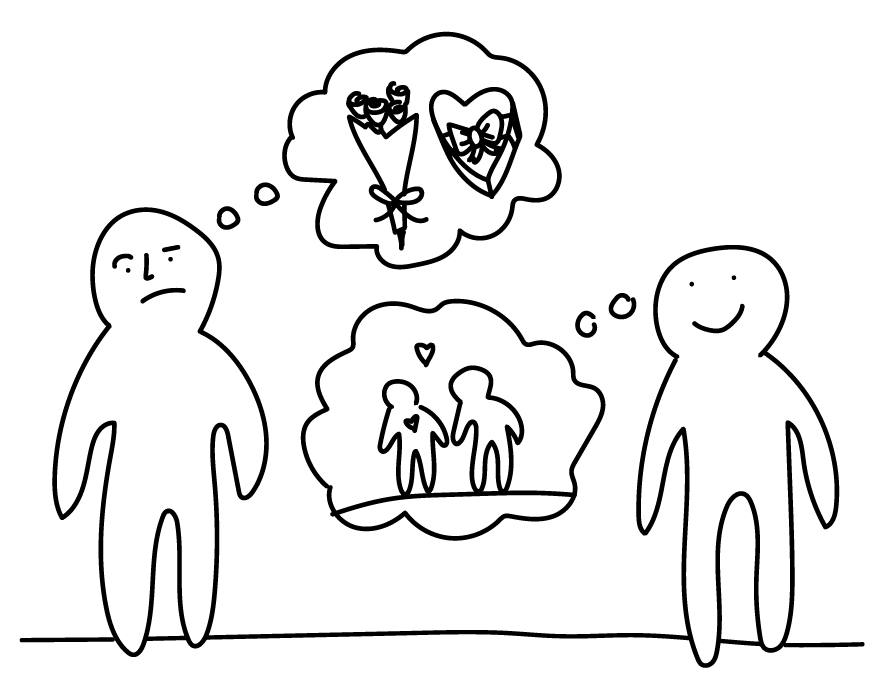Valentine’s Day is overcommercialized, xoxo
February 13, 2020
Love is in the air—and in wallets too, apparently.
It’s no surprise that holidays are commercialized to the point where they hold more meaning for corporations than for the people actually celebrating them. The pressure to show love on Valentine’s Day through gift giving not only encourages needless materialism but also de-emphasizes the original spirit of the holiday.
In 2009, 72% of adults aged 18-34 said they planned to celebrate Valentine’s Day, a number that dropped to 53% in 2019,
according to the National Retail Federation. In contrast, the total spending on the holiday in America rose from $14.7 billion to over $20 billion—an expected average cost of $162 per person, according to Business Insider.
The commercialization of Valentine’s Day isn’t just limited to couples. More recently, social trends have given birth to campaigns promoting self-love (treat yourself!) to encouraging further spending on friends to show platonic love. While it’s nice to think that the love celebrated on Valentine’s is more than romantic love, the holiday’s expanding inclusivity can be largely credited to businesses and their (very successful) attempts to keep the cash flowing.
While there are those who are ready to empty their wallets for their loved ones, on the other side of the spectrum lie the cynics who have become discouraged by aggressive marketing and in-your-face advertising. In fact, many have cited the ever-increasing commercialization of Valentine’s Day as a reason for opting out of celebrating it. In a survey from the Statista Research Department, 21% of respondents answered “Valentine’s Day is a purely commercial thing and doesn’t have anything to do with love,” while 27% responded that “Valentine’s Day is overrated.” In a world where consumerism and corporations hold so much influence, falling into the trap of overspending creates a norm that dulls the holiday spirit and only continues to worsen.
However, this isn’t a call to completely stop celebrating the holiday or a rebuke for those planning to splurge on gifts or a special night out. Whether celebrating romantic, platonic or selflove, the spirit of Valentine’s Day should remain the same. There is no right or wrong way to celebrate (or not celebrate)— after all, it’s only one out of the 365 days of the year that couples should be sharing their love for each other. Surprising your significant other with flowers for no
particular reason is even more meaningful than dinner on Valentine’s Day, which can almost feel like an obligation. The lack of grandeur on one specific day shouldn’t imply an absence of love, and it definitely shouldn’t necessitate pulling out the checkbook to show it. The pressure to lavish your lover with expensive gifts may actually do more harm than good by perpetuating the idea that the value of a relationship is equivalent to its monetary value. After all, shouldn’t love be priceless?
While pampering a lover on Valentine’s Day is often associated with the conventional gifts of flowers, chocolates and jewelry, these traditions are often prioritized above the said lover’s actual needs and wants. The popular idea of the five “love languages,” originating from Gary Chapman’s 1992 book, asserts that every person shows and experiences love through different manners—quality time, physical touch, acts of service, giving/receiving gifts and words of affirmation. Chocolate and movies might be the epitome of love for one person, but can come off as tacky and forced to someone else. Each person interprets and shows love in unique ways—for example, your partner might be thrilled instead by a personalized photo album, aquarium trip or a Spotify playlist that’s special to the two of you. Essentially, the idea of learning a partner’s love languages is another way to emphasize the importance of attentiveness—arguably the most important factor in a healthy relationship, and the key to communication.
Valentine’s Day is a time to translate those love languages into action. As consumers, we should be more mindful of how we spend our money and what kind of message that may send. Valentine’s Day can seem superficial and materialistic, but it doesn’t have to be. As long as we redirect the day’s focus to gratitude and appreciation—why we love them as much as we do, from their adorable laugh to their thoughtfulness to the fact that you just can’t live without them—we can make it more about appreciation and less about money.



![AAAAAND ANOTHER THING: [CENSORED] [REDACTED] [BABY SCREAMING] [SIRENS] [SILENCE].](https://thehowleronline.org/wp-content/uploads/2025/06/lucy-1200x800.jpg)





















































![AAAAAND ANOTHER THING: [CENSORED] [REDACTED] [BABY SCREAMING] [SIRENS] [SILENCE].](https://thehowleronline.org/wp-content/uploads/2025/06/lucy-300x200.jpg)
